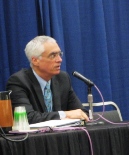
National Water Priorities from Perciasepe
 Robert Perciasepe made a few salient points Monday during his presentation on EPA’s national priorities to WEFTEC 2010 attendees in New Orleans.
Robert Perciasepe made a few salient points Monday during his presentation on EPA’s national priorities to WEFTEC 2010 attendees in New Orleans.
Noting that many plans have been developed for the Gulf ecosystem, Perciasepe said it is time to “lash up” nearer term and long-term objectives.
He served EPA under the Clinton Administration in both water and air positions, was Maryland’s secretary of the environment, and also held the position of director of planning for the City of Baltimore. In between the federal government gigs, Perciasepe worked for the birds at Audubon. So when he says, “collaboration is what is needed to really make a difference here,” he really may know what he is saying.
He also knows it’s going to take a lot of money. Perciasepe said 45 percent of EPA’s 2011 budget related to water – wastewater, water quality and drinking water. That does seem like a high percentage, doesn’t it? I know the agency has developed a number for how much money is needed to repair and replace water and wastewater infrastructure, but has anyone ever tried to determine how much is needed annually to reach the goal of closing the gap? If not, why not?
While trying to determine how the United States needed to deal with its clean water issues (I read this wastewater issues), the agency has been meeting with stakeholder groups, Perciasepe said. These meetings have developed a simple framework: know what you’ve got, identify the healthy waters and protect them, fix what’s broken, keep it clean, and enhance watershed resiliency and economic health. The language may be simple, but the execution surely won’t be.
Especially on the fix-it part. When the Clean Water Act was written, the United States had not identified or measured water quality like it does today. We know a lot more than we used to, but we still don’t know the answers. Perciasepe brought up TMDLs and from there segued to the idea that “large basinwide nutrient problems open the door to using market mechanisms.” Huh? That sounds like he wants investors to realize there’s money to be made … in nutrient trading? Maybe I missed something.
Oh yes, and the federal government should be leveraging its own resources. Perciasepe said EPA should be reaching out to other agencies, such as the U.S. Department of Agriculture, which conducts research on nonpoint source issues.
Good points all. I’m eager to see some action on this front. How about you?
Posted by L.K. Williams, EPonline on Oct 05, 2010